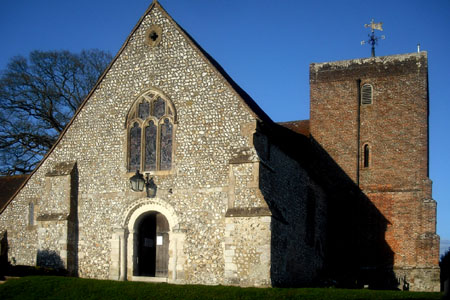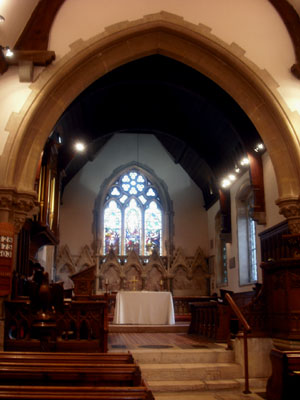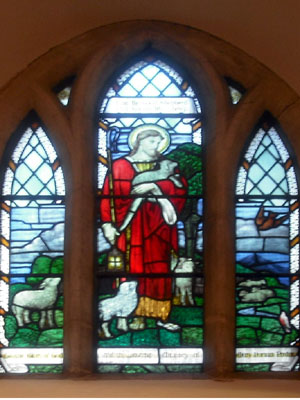| |
 |
 |
 |
| Comment on this report, or find other reports. |
 |
| Our Mystery Worshippers are volunteers who warm church pews for us around the world. If you'd like to become a Mystery Worshipper, start here. |
 |
| Find out how to reproduce this report in your church magazine or website. |
|
|
| 3012: St Mary, East Lavant, England |
 |
 |
 |
Mystery Worshipper: Teutonic Knight.
The church: St Mary, East Lavant, West Sussex, England.
Denomination: Church of England, Diocese of Chichester.
The building: St. Mary's is an unusual looking building, a little asymmetric, with piecemeal additions to the structure. It is originally Norman and has massive buttresses. The brick tower, which only houses a single bell, was added in the 17th century, and is somewhat out of keeping with the rest of the flint and rubble building. Unfortunately the Victorians completely and unsympathetically rebuilt the chancel, and little is left of the original structure except the west wall with its fine moulded doorway with recessed (“nook”) shafts. Inside, there are a wooden eagle lectern and carved pulpit, and they boast a set of five plain but fun early 16th century misericords in the choir stalls. The high altar with marble and stone reredos appears unused, but there is a table of the Lord's Supper just outside the closed altar rails. It seems out of place, blocking the entrance to the sanctuary. The carved Royal coat of arms is that of the Stuarts, which is unusual. Another notable feature is a coffin slab in the floor with an inscription in Norman French. There is some unspectacular stained glass, including a small squat window that depicts the Good Shepherd. Well, at least I could walk into a church on Good Shepherd Sunday and find myself looking at a window depicting the Good Shepherd.
The church: The Lavant churches include St Mary's and a second church, St Nicholas. They have gone through a difficult patch in the recent past after a rector of the "wrong" churchmanship and tradition was appointed, only to be moved elsewhere shortly after. So within a couple of years they had to deal with an interregnum twice. They also hit the headlines in the local press two years back with a contemporary piece of art by a local painter displayed near the font. The diocese deemed it "unashamedly modern" and too large, and demanded it be removed. They are only a few miles away from Chichester Cathedral, where avant-garde principles have been famously applied since World War II, so this seems a rather contradictory ruling. There is a very well-stocked library and a table with various pamphlets and booklets that give an indication of the spiritual engagement and also wealth of the parish. The community support a number of charities, and also sustain a link with Africa.
The neighbourhood: Lavant is a village just north of Chichester, divided between East and West Lavant by the river Lavant. However, the river flows discernibly only when the water table is high and can become a raging torrent in the wet season, when it courses through Chichester to spill into the sea, and has caused floods. The village green is a cricket ground (cricket is reputed to have been invented around here). There are a post office and two churches within half a mile of each other. The Lord of the Manor, who resides at Goodwood House, is the patron of the church, and the local pub is named for his oldest son. The village is close by the South Downs National Park, and the area has many attractions, among them a Bronze Age hill fort and burial mound (The Trundle), Goodwood House, a racecourse, and motor-racing circuit, as well as an aerodrome. The old railway line that used to connect Midhurst with Chichester runs just to the west and has been turned into a public path-cum-cycle-lane-cum-bridleway called the Centurion Way.
The cast: The Revd Philip Meader (retired), attired in cassock, surplice and black preaching scarf. The young organist was a pigtailed German from Leipzig, the "JS Bach capital", who curiously goes by the English Christian name of Luke.
The date & time: Fourth Sunday of Easter and Good Shepherd Sunday, 17 April 2016, 6.00pm.
What was the name of the service?
Evensong. But it was really Evening Prayer – see below.
How full was the building?
Eleven people, I think: a full front pew, some in the second, and a few people behind me.
Did anyone welcome you personally?
A friendly lady handed me the Prayer Book and pew sheet. Another friendly lady then immediately sat herself down in the pew in front of me and homed in, chatting amiably and filling me in on the recent history of the parish.
Was your pew comfortable?
Standard pews and embroidered hassocks in a well-heated building.
How would you describe the pre-service
atmosphere?
Light and relaxed; "sunny" despite the early evening hour. It gave me the freedom to wander about a bit and explore the church before the start of the service without feeling like an unwelcome sightseer or intruder on this beautiful spring day.
What were the exact opening words of the
service?
"Welcome for our service of evening prayer. We begin with a short silence and our first hymn, number 128."
What books did the congregation use during the
service?
Book of Common Prayer (1662). Copies of Hymns Old & New (Anglican edition) were stacked at the pew ends. There was a cardboard box chock-a-block with Bibles at the back of the church. They looked as though they were brand new arrivals about to be distributed.
What musical instruments were played?
Organ - a rather attractive but small instrument by William Hill & Son of London, 1895, which was restored in 2006.
Did anything distract you?
There was a brief moment of confusion because the hymn board displayed three hymns but not the psalm. There were a few nervous giggles, but no lectionary could be produced. The priest then announced that we would say the 23rd, an easy choice for Good Shepherd Sunday.

Was the worship stiff-upper-lip, happy clappy, or
what?
This is a church of just above middle-of-the-road Catholic tradition with preaching from the pulpit, so it came as somewhat of a surprise that the visiting priest raised one arm in a gesture of triumphant praise during the final hymn, then turned round to face the altar, lifting both arms high in joyful song. It looked so genuinely and exuberantly joyful that I was expecting the elders in Revelation 4 to appear in a cloud, falling down before the throne. I sang a bit louder.
Exactly how long was the sermon?
About 15 minutes, I guess. I forgot to check my watch at the end, as the sermon had completely absorbed my attention.
On a scale of 1-10, how good was the preacher?
8 – The Revd Philip Meader displayed a sense of purpose and humour. No hellfire and brimstone – just patience, love and understanding.
In a nutshell, what was the sermon
about?
The British Isles and the Anglophone world were evangelised by many notable characters, starting with the Celtic monks and saints, and proceeding through Augustine, George Whitfield, John Wesley, and the missionary societies. The Great Commission is to be taken seriously. The late Archbishop of Canterbury, Michael Ramsey, noted the vastly diminished influence of the Church in his time. Although that was almost half a century ago, we find ourselves increasingly in the same minority as St Paul and the early Christians. The Church today, like Paul, preaches a message of forgiveness through repentance to a world that does not want to hear. But all is not lost. We have the miracles of modern medicine to heal our bodies, but only the Church preaches the forgiveness of sin and healing through repentance. No medicine other than Jesus Christ can substitute moral responsibility. Our task is to witness to the forgiveness of sin, to preach repentance, and the Spirit will do the rest.
Which part of the service was like being in
heaven?
The visiting priest promised that there would be only one notice before the final hymn, and that it would genuinely tie in with the theme of the hymn: "Thine be the Glory." The churchwardens then stepped forward and announced that a new priest has finally been appointed. They gave a brief resumé of his previous ministry and assured everyone that "he has promised to love us all." There was a collective sigh of relief, and the final hymn was belted out and filled the church as though the entire parish was present. Being part of this small faithful community was very moving. They seemed genuinely excited.
And which part was like being in... er... the other place?
It was a disappointment that there was no choir, and the responses, psalm, canticles and collects were all said. This does not really qualify for the pit, but it was a pity.
What happened when you hung around after the service looking lost?
The same lady who had spoken to me earlier came back to chat afterward. No-one else did.
How would you describe the after-service
coffee?
None.
How would you feel about making this church your regular (where 10 = ecstatic, 0 = terminal)?
8 – Evensong is not really what would clinch the deal, particularly not if it is really evening prayer. However, this appears to be my type of church and village community, and I am sure I could be very happy here. Pity I'm that little bit too far away to make it a reality.
Did the service make you feel glad to be a
Christian?
Yes, indeed: "And the Spirit of God moved over the face of the deep." The Second Coming may be about to happen in this place.

What one thing will you remember about all this in seven days' time?
The atmosphere with the roof-raising singing of the few, |
|
|
 |
 |
 |
| We rely on voluntary donations to stay online. If you're a regular visitor to Ship of Fools, please consider supporting us. |
 |
 |
 |
| The Mystery Pilgrim |
 |
| One of our most seasoned reporters makes the Camino pilgrimage to Santiago de Compostela in Spain. Read here. |
 |
 |
 |
| London churches |
 |
| Read reports from 70 London churches, visited by a small army of Mystery Worshippers on one single Sunday. Read here. |
| |
|
|
|
|


